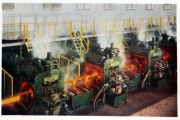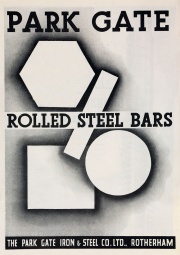Park Gate Iron and Steel Co

Park Gate Iron and Steel Co at Rotherham
The Park Gate Iron and Steel Company was situated in Parkgate on a triangular site bounded on two sides by the main Rotherham to Barnsley road (A633) and the North Midland Railway's main line between Rotherham and Cudworth Stations.
1823 The establishment of a Parkgate Ironworks by Samuel Sanderson and xx Watson. It was located at the junction of Rotherham Road and Taylors Lane with part of the works facing on to the Greasbrough Canal.
1832 The business was sold, becoming part of the Birmingham Tin Plate Co.
Over the years, along with the business changing hands several times, it expanded over Rotherham Road to the Park Gate site, which continued operation until the 1970s.
1833 William Oxley of Parkgate is listed under 'Steel Converters and Shear Steel Manufacturer' [1]
1839 The first blast furnace was installed
1841 William Scholefield of Parkgate Iron Works listed under Iron Manufacturers and Iron Masters. William Oxley and Co of Parkgate Steel Works listed as Steel Converters and Refiners. [2]
1845 Following another change in ownership, a mill for the rolling of railway lines was installed
1849 William Scholefield and Co of Parkgate and Holme Iron Works and Birmingham listed as Iron Manufacturers. William Oxley and Co of Parkgate listed under Steel Converters [3]
1853 Referred to as the 'Parkgate Iron Works of Messrs. Samuel Beale and Co of Birmingham'. [4]
1854 Samuel Beale and Co produced the cast iron armour plating for Isambard Kingdom Brunel's famous steamship the SS Great Eastern.
1864 Samuel Beale retired in 1864 and his son William Lansdowne Beale incorporated the company under the name Parkgate Iron Company Limited
1864 The company was established. [5]
1871 Two further blast furnaces were brought into operation and further new plant added over the following ten years, this including a slab mill, a large plate mill, a billet mill and three open hearth furnaces.
1880 Had ninety puddling furnaces which were soon abandoned as they moved from making wrought iron to steel
1880s Installed engine from Davey, Paxman and Co for cogging mill
1888 A further change of name took place when the company was renamed Parkgate Iron and Steel Co, which reflected the shift in its manufacturing base.
1890s Installed an engine from Markham and Co
1901 Parkgate Iron and Steel Co were boiler and ship plate manufacturers in 1901. [6]
By 1908 the works had gone over entirely to steel production and until 1946 its main products were steel ingots intended for further processing, in particular steel plate and armour plate for the shipbuilding industry and solid bar products ranging from 3/8" to 9 1/2". The company also produced sectional shapes and in particular arches and props for the mining industry.
1909 Installed an engine from Belliss and Morcom
1911 Installed engine from Lamberton and Co for the billet mill
1912 Installed engine from Galloways for the finishing mill
1913 Sir Charles John Stoddart the head of Parkgate Iron and Steel died. [7]
1914 Steel manufacturers. Specialities: high-class steel manufactured by Siemens process only; steel boiler plates, tank plates, bridge plates, sheets, chequered plates, flats, angles, tees and sectional bars of all descriptions; slabs and billets, dead soft and guaranteed carbons; high tensile steel in plates, sheets and bars; welding and case-hardening steel, pig iron, foundry and forge. Employees 1,500 to 2,000. [8]
1917 Installed engine from Scott and Hodgson for the cogging mill
Following the end of World War I, land was purchased at nearby Roundwood
By 1920, the tenth open hearth furnace was added and new rolling capacity on 12" and 14" rolling mills brought on stream.
1921 Installed engine from Markham and Co for the roughing mill.
1926 June. Mr. Charles Markham, presiding at the annual meeting of the company, at Sheffield, gave some interesting figures relating to the six South Yorkshire collieries for the month of April, which was a broken period. They raised £450,000 tons of coal and paid £229,000 in wages, or 10s. 2d. wages for each ton. That was divided among 18,000 workmen. Mr Markham further mentioned that during the past few years they had lost at Parkgate in strikes nearly £200,000. "That money had gone to nobody, it had brought up no revenue, and it had brought nothing but misery and hardship." [9]
1926 - November. A. K. Wilson joined the Board of Parkgate Iron and Steel Co, Ltd. in the place of the late Charles Markham. The other directors of the company were Douglas Vickers, Sir William B. Bird, A. Willis Dixon and P. W. Fawsett.[10]
1927 See Aberconway for information on the company and its history.
1934 See Park Gate Iron and Steel Co: 1934 Review
1948 The company was nationalised along with most of the other U.K.'s bulk steel producers.
1951 Nationalised under the Iron and Steel Act; became part of the Iron and Steel Corporation of Great Britain[11]
By 1953 plate steel was no longer being made and a new continuous bar mill was begun.
1956 the company was bought from the Holding and Realization Agency by Tube Investments [12]; development would be coordinated with that at Round Oak Steel Works; major development work was planned for a site at Aldwarke, to come on stream in the 1960s. This included 'Kaldo' process 'Basic Oxygen Steelmaking' Plant which was fed from the blast furnaces, ladles being transferred by rail between the sites. This development also included hot rolling facilities.
1960 the main site covered some 370 acres and the Roundwood site, adjacent to the ex-Midland Railway's main line to the north of the main works, and covering a further 220 acres, was coming on stream. The plant at that time included two mechanically charged blast furnaces feeding 10 open hearth steel making furnaces which, in turn, fed two primary mills for rolling blooms and billets and 5 finishing mills rolling a wide range of solid bars. The Roundwood site was occupied by an 11 inch Continuous Bar Mill. Capacity at the time was around 425,000 tons of carbon, low alloy and free-cutting steel and ingots.
1960 Charles Henry Trelease Williams appointed chairman of the Parkgate Iron and Steel Co. [13]
1967 Tube Investments's steel-making subsidiaries (Park Gate Iron and Steel Co, Round Oak Steel Works) nationalised into British Steel Corporation[14] as one of the 14 largest steel groups, representing about 90 per cent of the UK's steel making capacity[15].
1968 British Steel announce the closure of departments with 375 out of 5,270 losing their jobs
By the 1970s demand had changed and part of the old plant was demolished
1976 rolling capacity was increased with the coming on stream of the Thrybergh Bar Mill.
The remainder of the Parkgate site closed in 1982.
See Also
Sources of Information
- ↑ 1833 History & Directory of Sheffield, Rotherham
- ↑ 1841 Pigot & Co.'s Directory of Yorks, Leics ...
- ↑ 1849 General Directory of Sheffield
- ↑ The Times, Monday, May 16, 1853
- ↑ The Stock Exchange Year Book 1908
- ↑ White's Directory of Sheffield and Rotherham, 1901 p849
- ↑ The Times, Monday, May 26, 1913
- ↑ 1914 Whitakers Red Book
- ↑ The Engineer 1926/06/11
- ↑ The Engineer 1926/11/19
- ↑ Hansard 19 February 1951
- ↑ The Times, 17 February 1956
- ↑ The Times, Saturday, Sep 03, 1960
- ↑ The Times, 29 July 1967
- ↑ The Times, 1 May 1965
- The Engineer of 9th February 1968 p269
- The Steam Engine in Industry by George Watkins in two volumes. Moorland Publishing. 1978/9. ISBN 0-903485-65-6
- [1] Wikipedia
- Park Gate Iron and Steel Co: 1934 Review





































